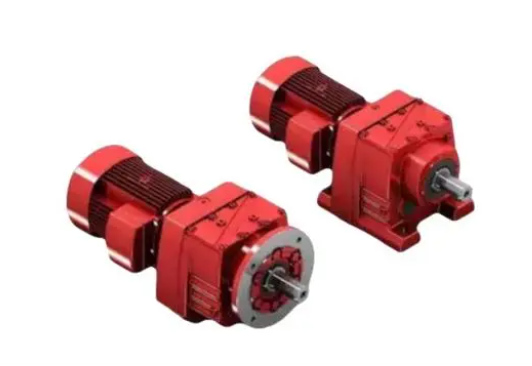What is a helical gear reduction motor?

A helical gear reduction motor is a transmission device that integrates an electric motor and a reducer, with the helical gear serving as the main component of the reducer. Due to its compact structure, high transmission efficiency, stable operation, and low noise, it is widely used in various mechanical transmission systems.
The main structure of a helical gear reduction motor includes three parts: an electric motor, a reducer, and an output shaft. Among them, the electric motor adopts AC or DC motor as the power source to drive the entire reducer; The reducer adopts a helical gear reduction structure, which transmits power and reduces speed through multi-stage gears; The output shaft transfers the decelerated power to the load.
In helical gear reduction motors, the design and manufacturing accuracy of helical gears have a significant impact on the performance of the entire reducer. The tooth profile design of helical gears requires precise calculation and optimization to ensure the meshing accuracy and transmission efficiency of the gears; Meanwhile, the machining of helical gears also requires the use of high-precision machine tools and cutting tools to ensure the machining accuracy and surface smoothness of the gears.
In addition, in order to adapt the helical gear reduction motor to different application scenarios and load conditions, it is necessary to adjust and optimize the parameters of the motor. For example, the speed and output torque of the motor can be adjusted by changing its voltage, current, or frequency; The reduction ratio and output speed of the reducer can also be changed by increasing or decreasing the number of reduction stages.
In practical applications, helical gear reduction motors have a wide range of applicability. It can be applied to various industrial automation production lines, conveying systems, packaging machinery, textile machinery, printing machinery and other fields, as a driving source or transmission device to achieve efficient and stable power transmission. Meanwhile, due to its compact structure and convenient maintenance, it also has obvious advantages in some space limited situations.
In summary, the helical gear reduction motor, as an efficient and stable transmission equipment, has broad application prospects in the fields of industrial automation and mechanical equipment. With the continuous progress of technology and the increasing demand for applications, the helical gear reduction motor will continue to play its important role and contribute to the development of industrial production and mechanical transmission technology.
In addition to the advantages mentioned above, the helical gear reduction motor also has the following characteristics:
1. Strong load-bearing capacity: The helical gear reduction motor adopts multi-stage helical gear transmission, which can withstand large loads and impact forces, and has high overload capacity and stability.
2. Smooth operation: Due to the large reduction ratio and relatively low output speed of the helical gear reduction motor, it runs smoothly, effectively reducing mechanical wear and vibration, and extending the service life of the equipment.
3. Strong applicability: The helical gear reduction motor can choose different motors and control methods according to different application scenarios, with good universality and interchangeability, making it easy to maintain and replace.
4. Easy installation: The helical gear reduction motor has a compact structure, light weight, and is easy to install and move, which can effectively reduce engineering costs and maintenance difficulties.
5. Energy conservation and environmental protection: The helical gear reduction motor adopts high-efficiency helical gear transmission, which can achieve reasonable energy utilization and reduce the impact on the environment, in line with the trend of modern industrial green development.

